
If you are a scuba diver, The Galapagos Islands should definitely be on your must-dive list. With some of the rarest and most fascinating sea creatures on the planet, you’ll enjoy exploring waters that are virtually the same as they were in prehistoric times.
This preserved gem of an archipelago has strong conservation laws protecting it, plus a remote location in the Pacific ocean more than 600 miles off the coast of Ecuador. This means the pristine sea is replete with turtles, sharks, manta ray and colorful reef fish. When it comes to scuba diving Galapagos tours, there are some things you should know to maximize your experience, like best times, best dive spots and how to book your tour.
Diving is great year-round in the Galapagos. The wet/warm season, between December to June, is considered by many the best time to scuba dive Galapagos. This is because there is calmer, warmer water and better visibility. This is also the season to see manta rays and hammerhead sharks. This time of year brings an average air temperature of 86 degrees and average water temperature of 70-75 degrees.
However, others (especially advanced divers) will dispute that the dry/cool season, from July to November, is the best time to dive. This is a very popular time because you can see whale sharks, one of the most majestic creatures of the sea. This time brings chillier water and choppier seas, with average air temps of 70 degrees and water temps between 62-68 degrees.
Moral of the story? Any time is potentially the best time to dive the Galapagos, depending who you ask. However, if you want the best of both worlds, May is a sweet spot for diving in terms of wildlife. In May, not only do you have a chance to see manta rays and hammerhead sharks, but there is a possibility you will see some early-arriving whale sharks as well.
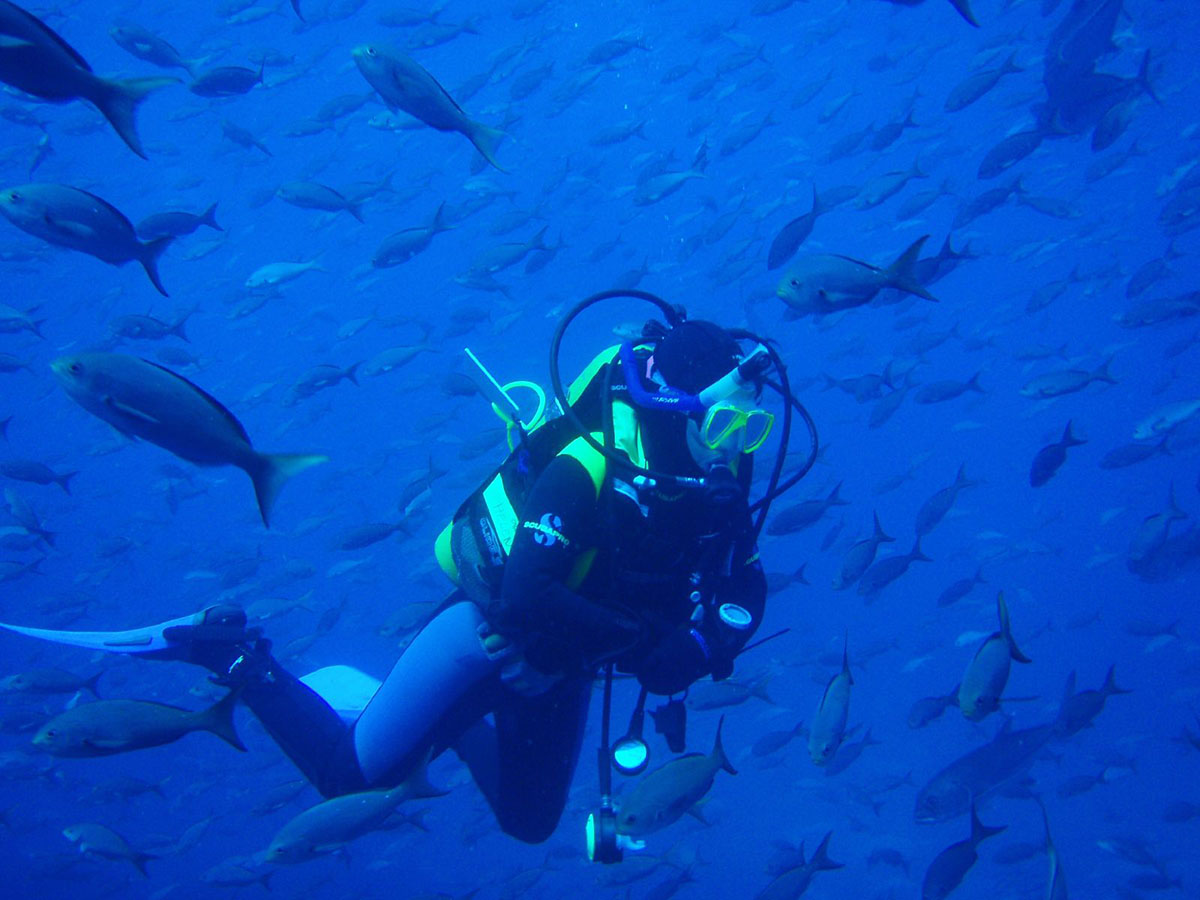
Image: Helen with Fish” by Anthony Patterson, used under CC BY 2.0 / Compressed from original.
While there are dive spots for beginners and intermediates, generally speaking the Galapagos are better suited to advanced divers. This is especially true between the months of June and November (dry/cool season), when waters are colder and rougher, with strong currents and rocky underwater surfaces.
The depths for Galapagos diving are often between 70-114 feet, while beginner depths are typically between 30-67 feet. If someone with limited diving experience wishes to scuba the Galapagos, it is best at an easier site between the months of December to June when the waters are calmer and warmer. Jump ahead for best dive spots and their difficulty level.
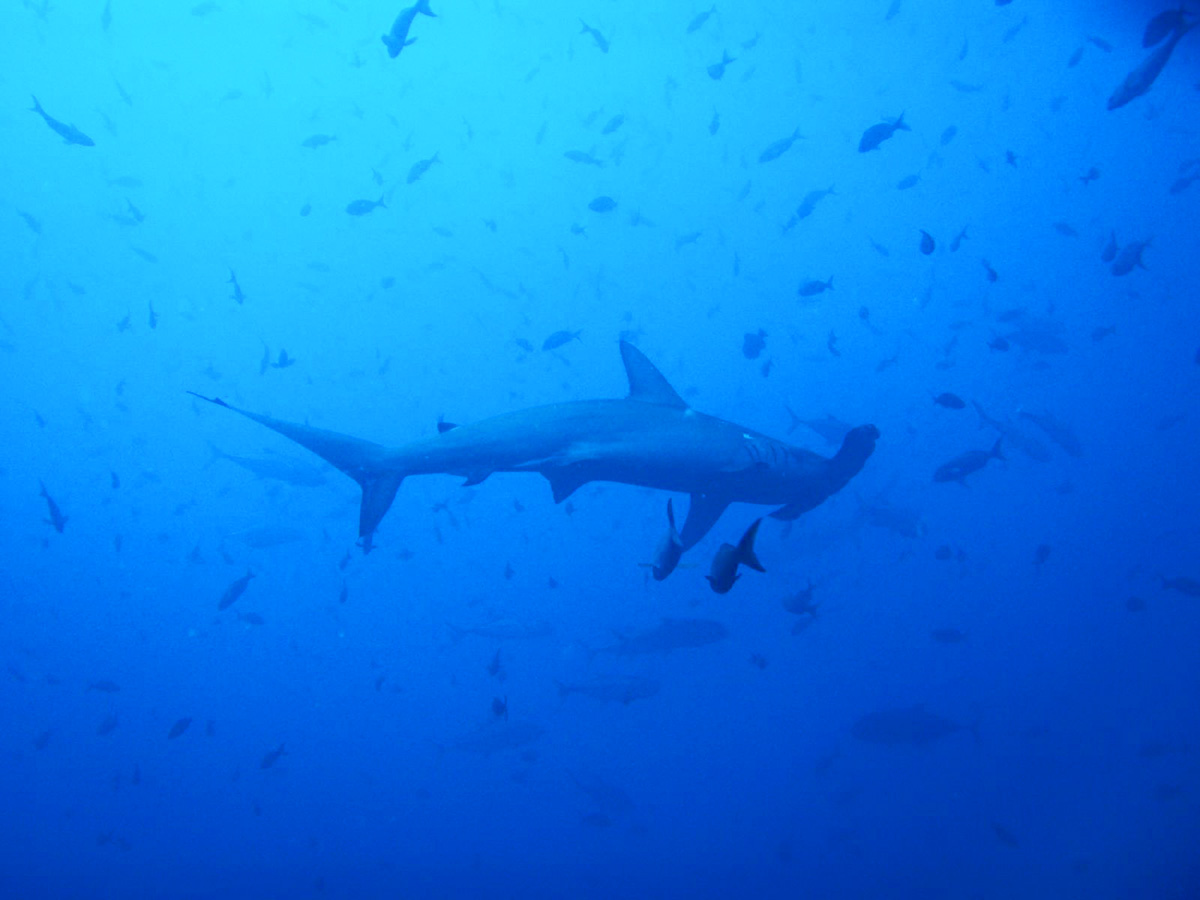
Hammerhead sharks are most active December-June. Image: Hammerhead” by Anthony Patterson, used under CC BY 2.0 / Adjusted brightness and compressed from original.
All divers must be PADI or SSI certified. Beyond that, there are dive sites for all levels from beginner to intermediate to advanced. There are even some scuba schools on the island that allow complete beginners to take their very first practice dives with qualified instructors. Many of the sites have a minimum number of required dives, with intermediate level sites typically requiring around 10 logged dives and more advanced sites requiring 15, 20 or even 30 logged dives.
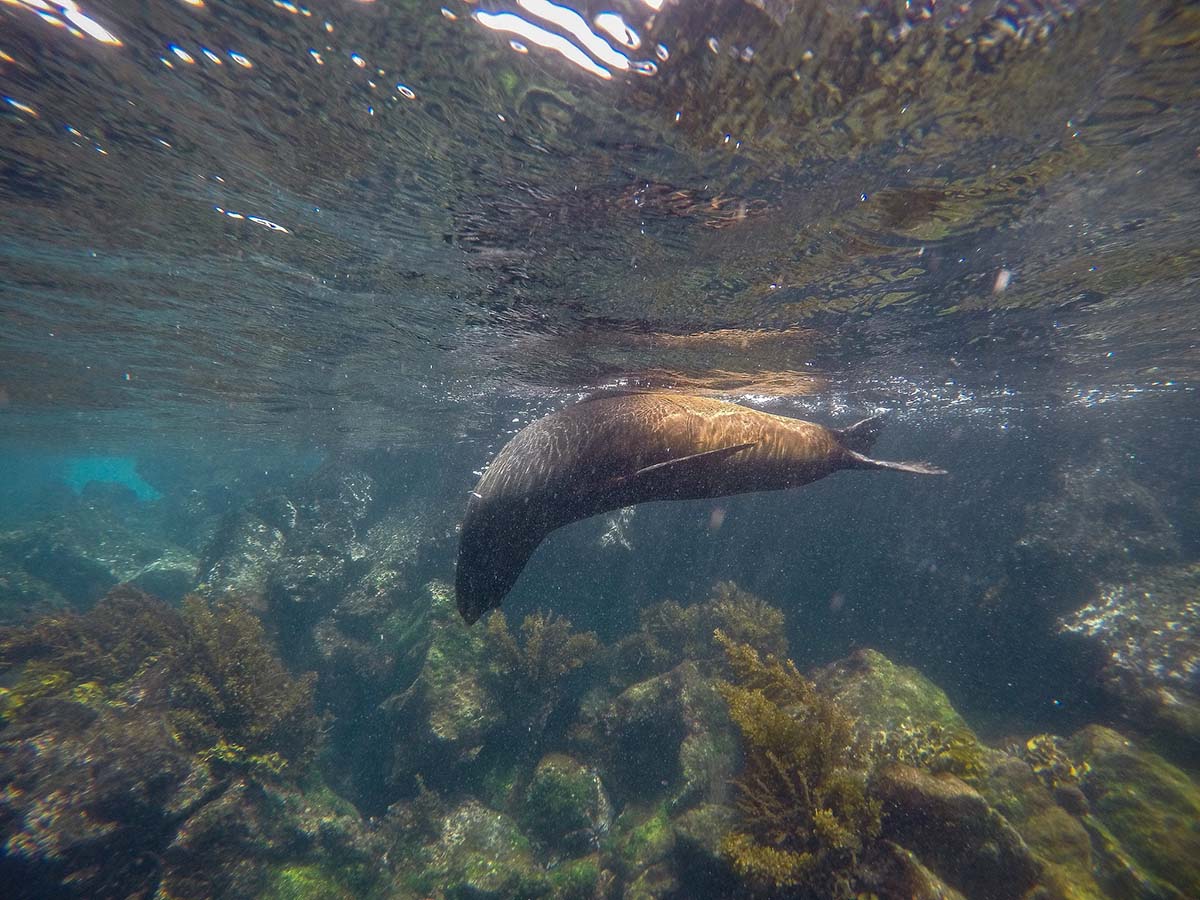
Sea lion playing at the surface. mage: GOPR5410” by David Ceballos, used under CC BY 2.0 / Compressed from original.
In the Galapagos, there are a few things to keep in mind when it comes to diving:
*A qualified travel advisor will book your trip ensuring all of these safety measures are met.
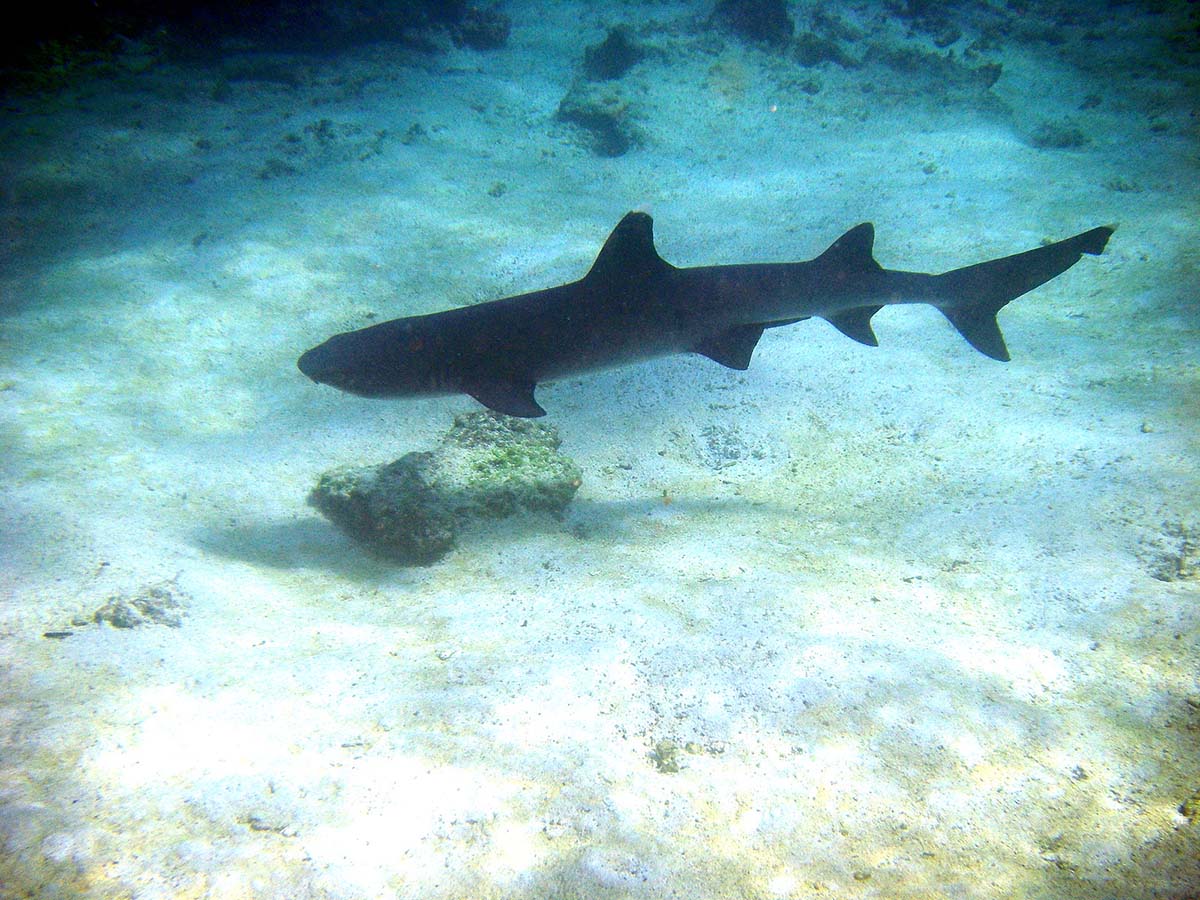
Reef shark. Image: Shark” by Rinaldo Wurglitsch, used under CC BY 2.0 / Compressed from original.
The flora and fauna is so pristine you will think you dived into prehistoric waters. When scuba diving in the Galapagos, aside from the amazing and colorful coral, algae and seaweeds you’ll see, here are some of the animals you can spot and when they are most commonly spotted:
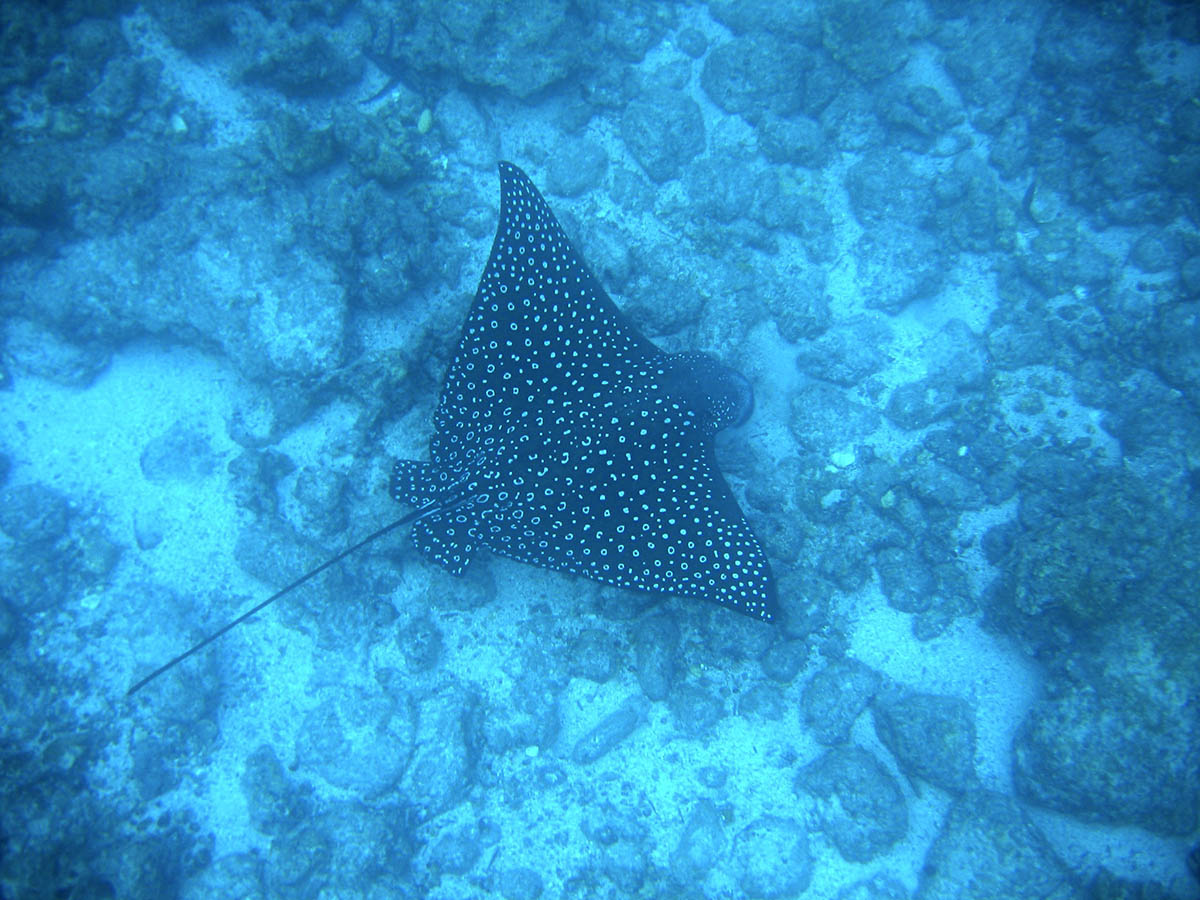
Eagle ray. Image: eagleray2.jpg” by taquiman, used under CC BY-SA 2.0 /Compressed from original.
Galapagos has world class diving that brings some of the most amazing creatures of the sea before your very eyes. Check out these top Galapagos dive sites, ranging from beginner to intermediate to advanced.
Academy Bay is located at Puerto Ayora on Santa Cruz Island. Here, divers have a chance to see (depending on the season) Galapagos sea lions, manta ray, green sea turtles, spotted eagle ray, hammerhead sharks and whale sharks.
Nearest Main Island: Santa Cruz Island
Difficulty Level: Beginner
A relaxed dive site off Santa Cruz Island (about two miles off the coast from Puerto Ayora) where divers of all levels may catch a glimpse of white-tipped reef sharks, sea lions, marine iguanas and seahorses.
Nearest Main Island: Santa Cruz Island
Difficulty Level: Beginner
North Seymour Island is an exciting, open level dive site where divers can see turtles, sea lions, eagle rays, reef fish, Galapagos garden eels, white-tip reef sharks and even some hammerheads depending on the season.
Nearest Main Island: Baltra Island
Difficulty Level: Beginner
This small island with calmer waters and sandy ocean floors is an excellent place to spot garden eels, colorful fish and hammerhead sharks in the right season. It is conveniently located between Baltra and North Seymour Islands.
Nearest Main Island: Baltra Island
Difficulty Level: Beginner
This small island just north of Floreana Island is an amazing spot for lovers of the flora of the sea. Down the rock wall you can see fascinating black coral bushes and yellow cup coral, along with some curious green turtles, surgeonfish, Pacific seahorse and hawkfish.
Nearest Main Island: Floreana Island
Difficulty Level: Beginner
This dive site off a famous hiking point on San Cristobal island is known for its calm clear waters that welcome divers of all levels. Here you have a chance to spot green sea turtles, rays, Galapagos garden eels, angelfish, grunts and playful sea lions.
Nearest Main Island: San Cristobal Island
Difficulty Level: Beginner
This is one of the most famous dive sites in the Galapagos, located off San Cristobal Island. The amazing rock formation is the ultimate habitat for an abundance of marine life, like pelagic and reef fish, whitetip sharks, Galapagos sharks, huge rays, sea turtles and sea lions.
Nearest Main Island: San Cristobal Island
Difficulty Level: Beginner
This is a fascinating spot to see the famous flora and fauna of the Galapagos. One of the most popular dive sites, here you can see sea lions, sting rays, eagle rays, manta rays, Galapagos sharks, white tip reef shark, sea horses, barracudas, turtles and reef fish among the black coral and colorful algae.
Nearest Main Island: Santiago Island
Difficulty Level: Intermediate
Dive into the waters of Punta Vicente Rock, located to the northwest of Isabela Island. These biodiverse seas are bursting with vibrant reef fish, stingrays, manta rays, Port Jackson shark, Pacific green sea turtles, marine iguanas, Galápagos fur sea lions, sea lions, white-tipped reef sharks, hammerhead sharks, playful penguins and more.
Nearest Main Island: Isabela Island
Difficulty Level: Intermediate
This dive site to the northeast of Santa Cruz Island is one of the most popular dive sites for intermediate and advanced divers. Sometimes called the washing machine because of its strong currents, the site requires 30 minimum logged dives. Among the commonly spotted creatures are hammerhead sharks, Galapagos sharks, mola mola, giant sea turtles, mobula rays, sting rays, eagle rays, Galapagos eels, barracudas and more.
Nearest Main Island: Santa Cruz Island
Difficulty Level: Intermediate to Advanced
This hidden gem of a dive spot is one of the best in the islands, though not as talked about as the more popular Gordon and Kicker Rocks. Located southeast of Isabela Island, here you can spot Galapagos sharks, Galapagos sheep head, Galapagos groupers, mantas, stingrays, sunfish, and maybe even hammerhead sharks and white-tipped sharks.
Nearest Main Island: Isabela Island
Difficulty Level: Intermediate to Advanced
Bartholomew Point is on Bartholomew Island, a small island east of Santiago Island that offers some excellent diving. With a fascinating underwater cliff, you’ll feel like you just submerged into a mystical fairytale. The moderate currents bring with them turtles, white tip reef sharks, reef fish, barracudas, sea horses, sting rays, stone fish and invertebrates.
Nearest Main Island: Santiago Island
Difficulty Level: Intermediate to Advanced
Aside from being one of the best dive spots in the Galapagos, Darwin’s Arch is believed to be one of the best dive spots in the entire world. Here is a spot where hammerhead sharks congregate and you can swim with giant whale sharks. Extremely remote and with limited access, this site is just off Darwin’s Island and those lucky enough to dive it also can spot green turtles, majestic manta rays, dolphins and more.
Nearest Island: Darwin Island
Difficulty Level: Intermediate to Advanced
Dive around these massive volcanic rocks off the tiny, remote Wolf Island. The island has many dive sites with varying difficulty levels, where you can spot eagle rays, iguanas, turtles, Galapagos sharks, hammerhead sharks, sea lions, penguins, whale sharks, seals and more. Wolf Island Galapagos is located not too far from Darwin’s Island, and both are reserved exclusively for divers.
Nearest Island: Wolf Island
Difficulty Level: Advanced
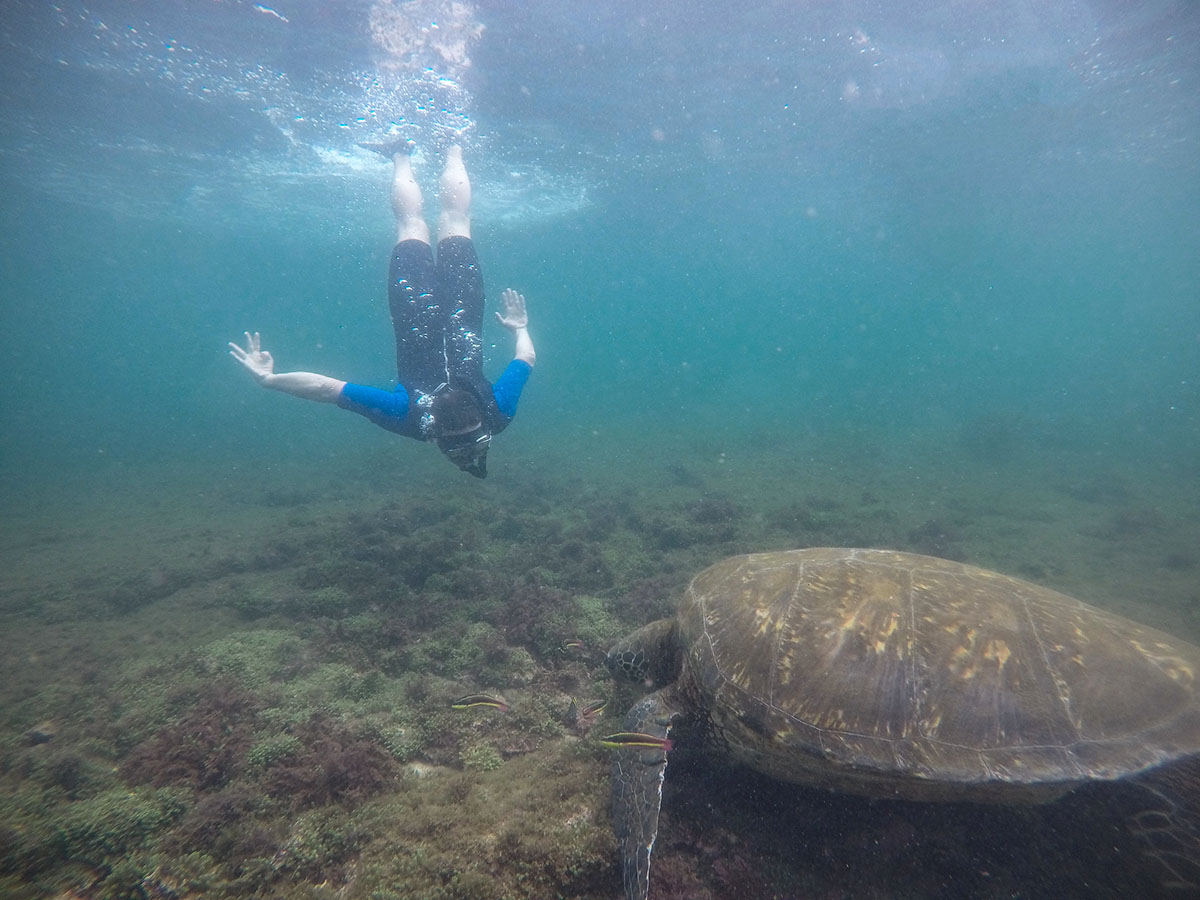
Diving with sea turtles is an unforgettable experience. mage: GOPR5410” by David Ceballos, used under CC BY 2.0 / Compressed from original.
At Peru for Less, we offer a variety of custom Galapagos tours. Divers can enjoy an land-based island-hopping tour, or they can savor the Galapagos by sea on a cruise. Our expert travel advisors work closely with each and every traveler to build the ultimate trip.
Here are some FAQs with answers from our expert travel advisors Adam, Rylee and Jackie!
Galapagos Tours:
Adam: They inform us in advance of their diving experience and what types of wildlife they might be hoping to see. Certain locations might be better for seeing hammerhead sharks, for example, and that is important to note so that we can provide them with the best experience possible.
Jackie: We also ask them about their dive preferences, and their experience level: are they advanced divers? Only have 1-5 logged dives? Etc. We will then find out their travel time frame, and customize an experience that works for their dates, number of available days, and dive experience.
Jackie: Short answer: yes! Long answer: it’s MUCH easier to include diving in a land package. This is because divers must wait 12-24 hours after flying to dive, or after diving to fly. Since cruises only offer diving on set days, it’s hard to include this for a traveler (especially if they have a diving area they are interested in). Land packages allow the flexibility of diving on any day of the package, which makes it easy to line up dive days with fly days.
Rylee: In addition, like the rest of the Galapagos, the diving spots are highly regulated and you can only dive in government-selected sites, which is why certain sites are not available on every cruise. An island hopping route is much easier to coordinate and they could even schedule more than one day of diving.
Adam: Yes, they will always have a certified diving guide with them and most are in groups. A lot of diving companies have set departures for diving sites based on levels and the number of dives completed.
Jackie: Of course, if no one else has signed up for the scuba that day, it may be just them and the guide.
Note: An additional private guide may also be available at an additional cost, if the diver is with kids or feels they need special attention.
Adam: Yes and no. If they have a specific site in mind we may need to shift their itinerary around so it hits that day. As the companies only have permission to visit certain sites on particular days, we cannot guarantee that unless they are a bit flexible with their schedule.
Rylee: Usually, it’s difficult to confirm an exact spot as the Galapagos regulations often change and only allow a certain amount of people per day in certain areas. For example, if a provider has specific days of the week that go to certain famous destinations (Gordon Rocks, etc.), there’s still a risk that things can change based on Galapagos availability.
Jackie: This would be challenging because…
Rylee: Gear is included in the cost of the tour.
Adam: Note that they do have a 12-liter tank included but if you want a bigger tank of air it’s usually extra. Also you can pay extra for NITROX Tanks.
Adam: The first thing all travelers should know is that they must be dive certified to do any diving in the Galapagos. Some sites as well will require a minimum of open water dives to be completed before visiting. Most of the sites though are open for all levels of divers.
Rylee: As mentioned, some areas are “advanced” and others are “beginner”, so it’s good to get an idea how experienced the divers are; and how many hours of diving is required to dive in a specific site.
Jackie: You can be even a beginner or intermediate diver to dive in the Galapagos! We will just need to ensure we schedule a dive site that is suitable for your experience level.
*Please note this is a sample only. Exact dive spots are determined based on time of year/week traveling, National Park restrictions and weather patterns.
*Please note this is a sample only. These times can be different depending on the tour operator and distance of the sites.
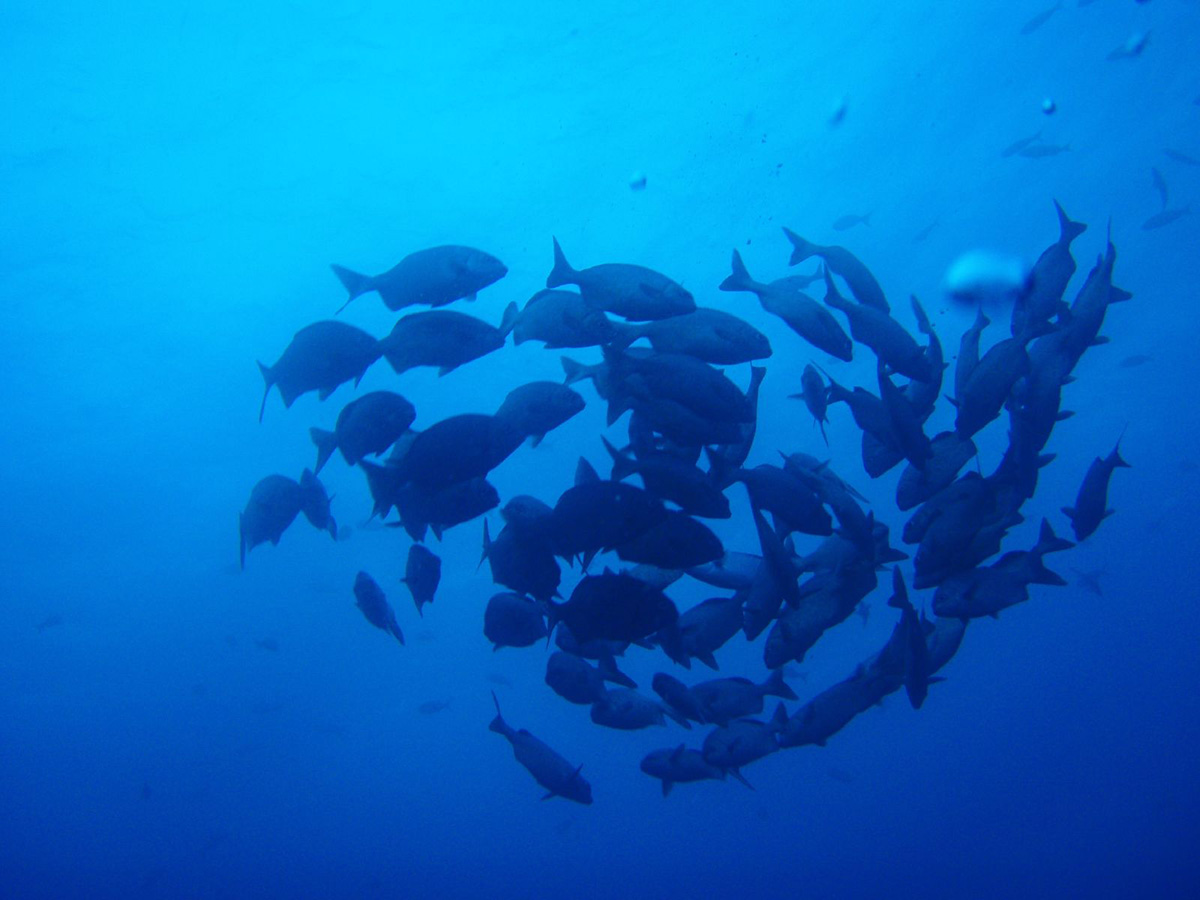
Image: P7020280” by Anthony Patterson, used under CC BY 2.0 / Compressed from original.
If you’re scuba diving in the Galapagos, these are the items you will want to make sure you have. While some of the more basic items can be rented, experienced divers tend to prefer to use their own for better fit and reliability.
For a general Galapagos packing list, see our Ultimate Galapagos Packing List blog.
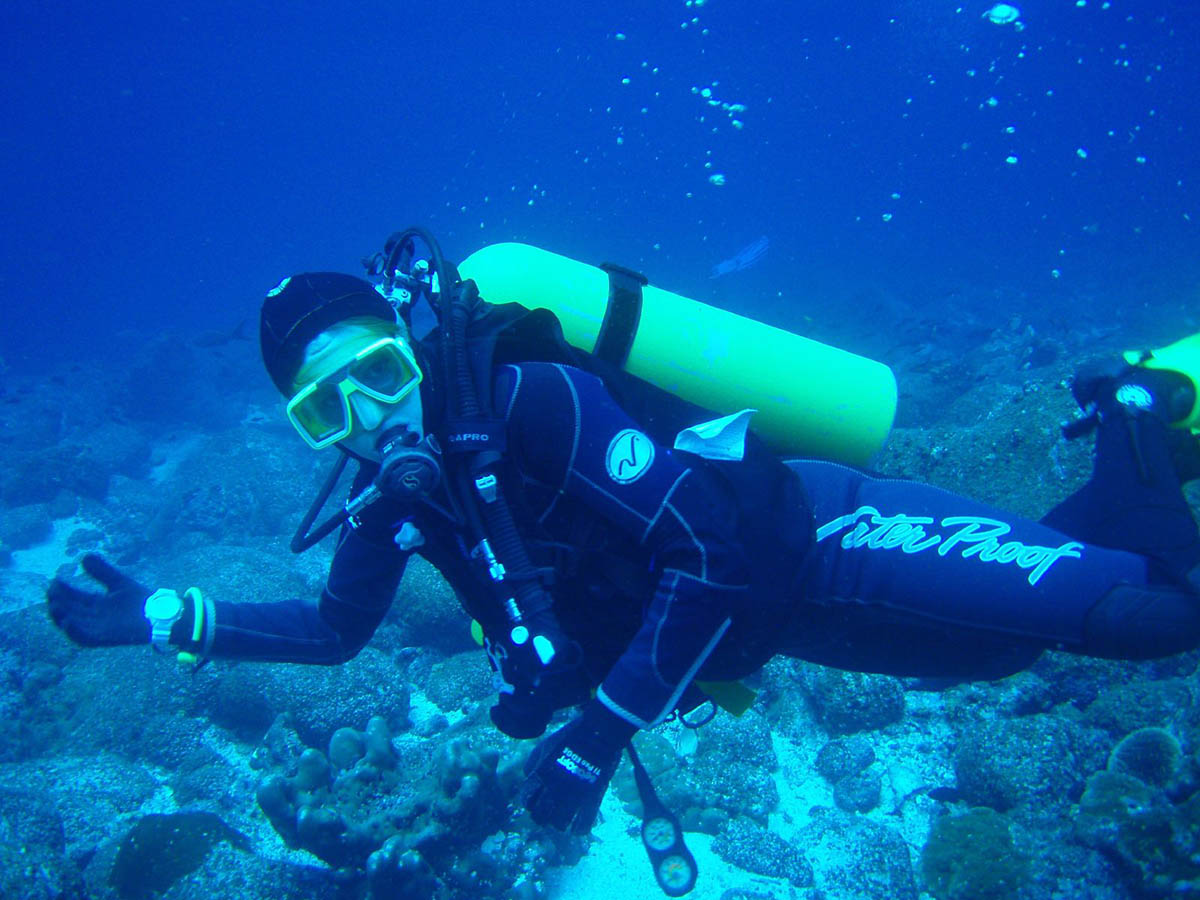
Image: Must write that review” by Anthony Patterson, used under CC BY 2.0 / Compressed from original.
Diving in the Galapagos is an unbelievable experience, and allows you to grasp the magnificence of these preserved islands and their surrounding seas. Due to protection and conservation of the island, and the differing wildlife sightings depending on the year and weather conditions, it is a good idea to work closely with a knowledgable travel advisor who can take care of the details. They can book you the ultimate diving trip, so you can spend less time worrying about logistics, and more time spotting sharks, turtles, dolphins and more on the dive of a lifetime!

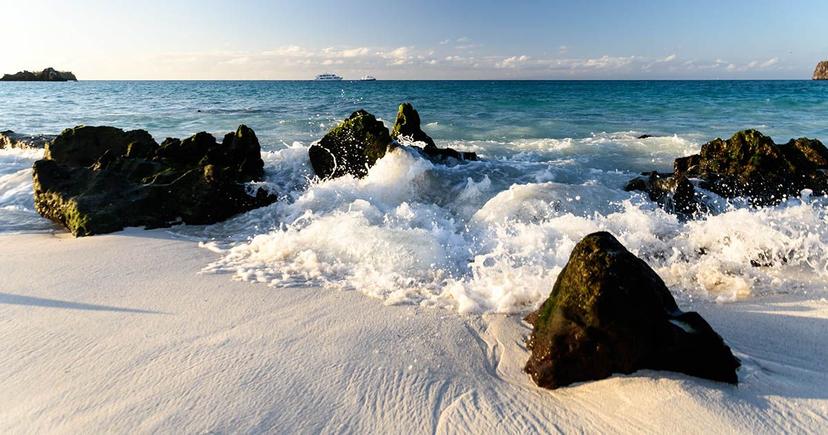

Email: [email protected]
Sign up to receive our newsletter for great articles, stunning photos, and special deals.